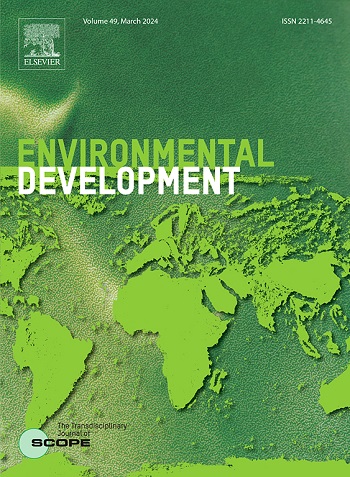巴格马蒂河贫民窟的固体废物特征--尼泊尔加德满都的案例
IF 5.3
2区 环境科学与生态学
Q2 ENVIRONMENTAL SCIENCES
引用次数: 0
摘要
固体废物管理(SWM)是全球面临的一个具有挑战性的环境问题,发展中国家在高效和有效地实施这一问题方面遇到了相当大的困难。据报道,由于居民社会经济地位低、人口密度高、基础设施不足以及非正规经济蓬勃发展等多种因素,这些地区的城市贫民窟尤其在固体废物管理方面面临独特的挑战。尽管存在这些重大问题,但尼泊尔的大部分 SWM 研究都集中在大城市和旅游热点地区。因此,在研究和政策讨论中,城市贫民窟地区(通常位于尼泊尔主要河流沿岸)的 SWM 状况仍然是一个被忽视的重要方面。因此,本研究旨在评估位于巴格马蒂河(尼泊尔首都加德满都的主要河流系统)沿岸人口稠密的城市贫民窟地区的 SWM 情况。研究选取了加德满都中心城区的四个主要贫民窟--西纳曼加尔、塔帕塔利、特库和巴尔库,并对家庭固体废物进行了系统随机抽样和特征描述。结果显示,四个研究地点的平均家庭固体废物产生率分别为 155.32 克/人-1 天-1、124.69 克/人-1 天-1、149.9 克/人-1 天-1 和 218.44 克/人-1 天-1。有机废物最多,占废物总量的 63.34%,其次是纸和纸制品(13.72%)、塑料(12.15%)、泥土和建筑垃圾(5.57%)、玻璃(4.31%)和其他废物(0.91%)。调查的定性数据显示,虽然存在城市废物管理计划,但居民的意识和参与程度有限。因此,许多家庭最终只能自行处理垃圾,而这种不科学的方式往往会污染附近的河水。这项研究为政策制定者、运营者和监管者提供了重要的启示,帮助他们应对日益严峻的生活垃圾管理挑战。预计研究结果将有助于首都中心城区沿河流域固体废物的可持续管理。在尼泊尔新的联邦治理体系下,建议省级和地方政府与包括家庭在内的所有利益相关者合作,制定全面、多模式的 SWM 战略,同时满足贫民窟地区的需求。本文章由计算机程序翻译,如有差异,请以英文原文为准。
Solid waste characterization in the slum areas of Bagmati River—A case of Kathmandu, Nepal
Solid waste management (SWM) is a challenging environmental issue globally, with developing nations experiencing considerable difficulties in its efficient and effective implementation. Urban slum areas within these regions, particularly, have been reported to face unique challenges in SWM due to a combination of factors, including the low socio-economic status of residents, high population density, inadequate infrastructure, and a thriving informal economy. Despite these critical concerns, most SWM research in Nepal has concentrated on major cities and tourist hotspots. As a result, the condition of SWM in urban slum areas, typically found along the banks of major rivers in Nepal, remains a critical yet neglected aspect in research and policy discussions. This study, therefore, aims to evaluate SWM in the densely populated urban slum areas situated along the Bagmati River, a key river system in Kathmandu, the capital of Nepal. Four major slum locations within the central metropolitan area of Kathmandu—Sinamangal, Thapathali, Teku, and Balkhu—were selected for the study, and systematic random sampling and characterization of household solid waste was conducted. The results reveal that the average household solid waste generation rates in the four study sites were 155.32 g capita−1 d−1, 124.69 g capita−1 d−1, 149.9 g capita−1 d−1, and 218.44 g capita−1 d−1, respectively. Organic wastes was the most prevalent type, comprising 63.34% of the total waste, followed by paper and paper products (13.72%), plastics (12.15%), dirt and construction debris (5.57%), glass (4.31%), and other wastes (0.91%). Qualitative data from the survey revealed that although municipal waste management programs exist, awareness and participation among residents were limited. As a result, many households ended up managing their waste on their own, often in an unscientific manner polluting the river water in the vicinity. The study offers critical insights for policymakers, operators, and regulators in addressing the growing challenges of SWM. Findings are expected to aid in the sustainable management of solid waste along the river basin in central urban regions of the capital city. Under Nepal's new federal governance system, provincial and local governments are recommended to collaborate with all stakeholders, including households, to develop comprehensive, multimodal SWM strategies that also address the needs of slum areas.
求助全文
通过发布文献求助,成功后即可免费获取论文全文。
去求助
来源期刊

Environmental Development
Social Sciences-Geography, Planning and Development
CiteScore
8.40
自引率
1.90%
发文量
62
审稿时长
74 days
期刊介绍:
Environmental Development provides a future oriented, pro-active, authoritative source of information and learning for researchers, postgraduate students, policymakers, and managers, and bridges the gap between fundamental research and the application in management and policy practices. It stimulates the exchange and coupling of traditional scientific knowledge on the environment, with the experiential knowledge among decision makers and other stakeholders and also connects natural sciences and social and behavioral sciences. Environmental Development includes and promotes scientific work from the non-western world, and also strengthens the collaboration between the developed and developing world. Further it links environmental research to broader issues of economic and social-cultural developments, and is intended to shorten the delays between research and publication, while ensuring thorough peer review. Environmental Development also creates a forum for transnational communication, discussion and global action.
Environmental Development is open to a broad range of disciplines and authors. The journal welcomes, in particular, contributions from a younger generation of researchers, and papers expanding the frontiers of environmental sciences, pointing at new directions and innovative answers.
All submissions to Environmental Development are reviewed using the general criteria of quality, originality, precision, importance of topic and insights, clarity of exposition, which are in keeping with the journal''s aims and scope.
 求助内容:
求助内容: 应助结果提醒方式:
应助结果提醒方式:


